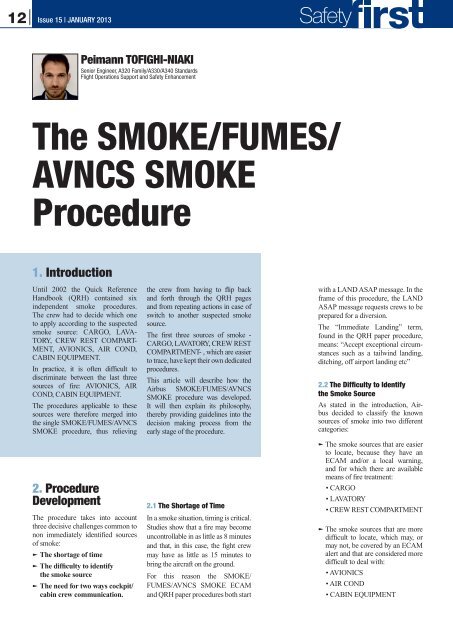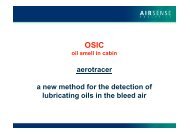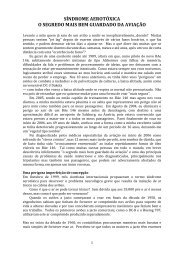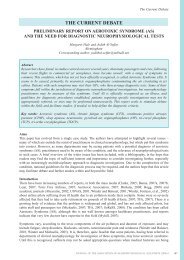Create successful ePaper yourself
Turn your PDF publications into a flip-book with our unique Google optimized e-Paper software.
12 Issue 15 | January 2013 Safety<br />
Peimann TOFIGHI-NIAKI<br />
Senior Engineer, A320 Family/A330/A340 Standards<br />
Flight Operations Support and Safety Enhancement<br />
The SMOKE/FUMES/<br />
AVNCS SMOKE<br />
Procedure<br />
1. Introduction<br />
Until 2002 the Quick Reference<br />
Handbook (QRH) contained six<br />
independent smoke procedures.<br />
The crew had to decide which one<br />
to apply according to the suspected<br />
smoke source: CARGO, LAVA-<br />
TORY, CREW REST COMPART-<br />
MENT, AVIONICS, AIR COND,<br />
CABIN EQUIPMENT.<br />
In practice, it is often difficult to<br />
discriminate between the last three<br />
sources of fire: AVIONICS, AIR<br />
COND, CABIN EQUIPMENT.<br />
The procedures applicable to these<br />
sources were therefore merged into<br />
the single SMOKE/FUMES/AVNCS<br />
SMOKE procedure, thus relieving<br />
2. Procedure<br />
Development<br />
The procedure takes into account<br />
three decisive challenges common to<br />
non immediately identified sources<br />
of smoke:<br />
q The shortage of time<br />
q The difficulty to identify<br />
the smoke source<br />
q The need for two ways cockpit/<br />
cabin crew communication.<br />
the crew from having to flip back<br />
and forth through the QRH pages<br />
and from repeating actions in case of<br />
switch to another suspected smoke<br />
source.<br />
The first three sources of smoke -<br />
CARGO, LAVATORY, CREW REST<br />
COMPARTMENT- , which are easier<br />
to trace, have kept their own dedicated<br />
procedures.<br />
This article will describe how the<br />
Airbus SMOKE/FUMES/AVNCS<br />
SMOKE procedure was developed.<br />
It will then explain its philosophy,<br />
thereby providing guidelines into the<br />
decision making process from the<br />
early stage of the procedure.<br />
2.1 The Shortage of Time<br />
In a smoke situation, timing is critical.<br />
Studies show that a fire may become<br />
uncontrollable in as little as 8 minutes<br />
and that, in this case, the fight crew<br />
may have as little as 15 minutes to<br />
bring the aircraft on the ground.<br />
For this reason the SMOKE/<br />
FUMES/AVNCS SMOKE ECAM<br />
and QRH paper procedures both start<br />
with a LAND ASAP message. In the<br />
frame of this procedure, the LAND<br />
ASAP message requests crews to be<br />
prepared for a diversion.<br />
The “Immediate Landing” term,<br />
found in the QRH paper procedure,<br />
means: “Accept exceptional circumstances<br />
such as a tailwind landing,<br />
ditching, off airport landing etc”<br />
2.2 The Difficulty to Identify<br />
the Smoke Source<br />
As stated in the introduction, Airbus<br />
decided to classify the known<br />
sources of smoke into two different<br />
categories:<br />
q The smoke sources that are easier<br />
to locate, because they have an<br />
ECAM and/or a local warning,<br />
and for which there are available<br />
means of fire treatment:<br />
• CARGO<br />
• LAVATORY<br />
• CREW REST COMPARTMENT<br />
q The smoke sources that are more<br />
difficult to locate, which may, or<br />
may not, be covered by an ECAM<br />
alert and that are considered more<br />
difficult to deal with:<br />
• AVIONICS<br />
• AIR COND<br />
• CABIN EQUIPMENT







